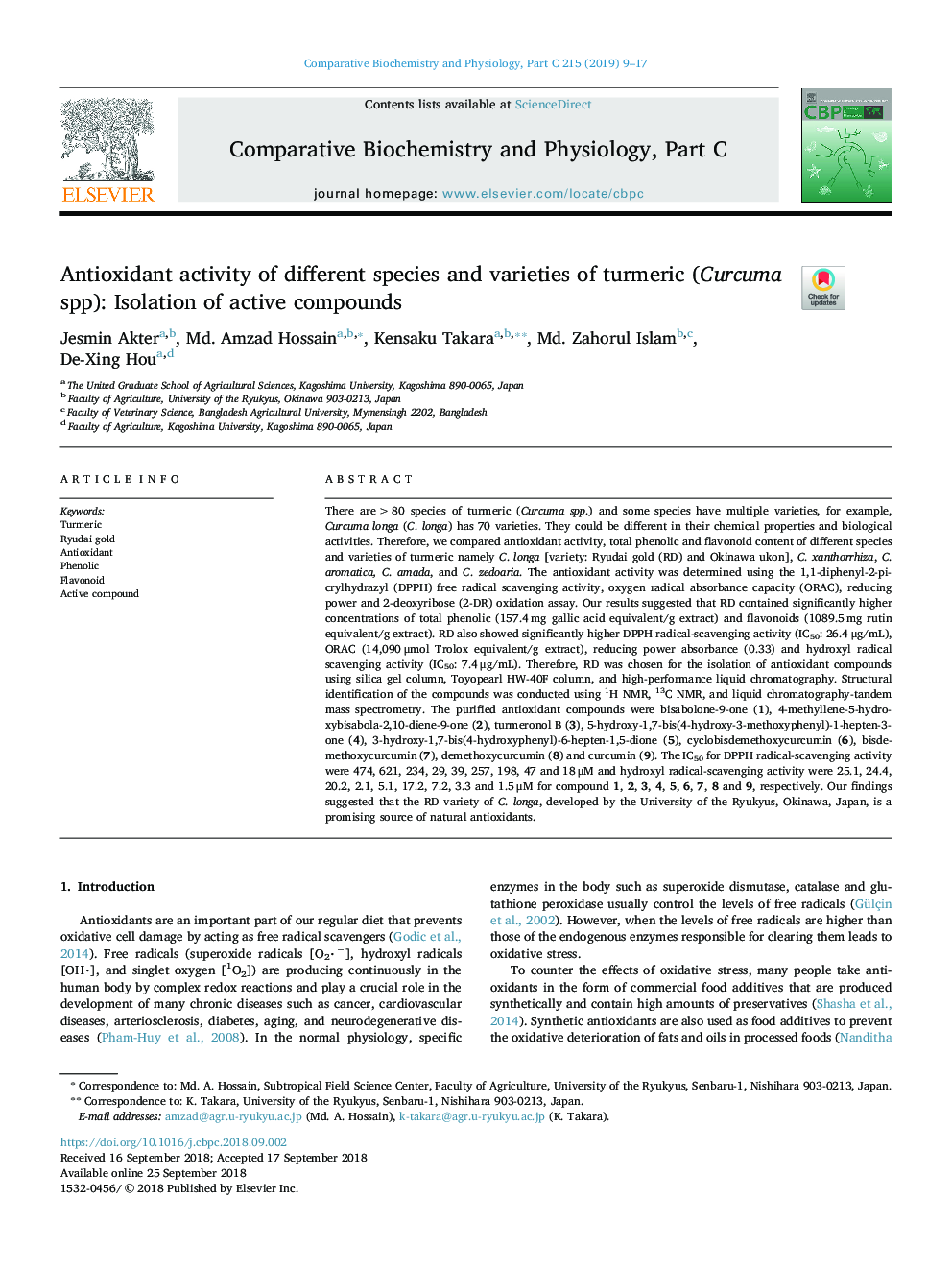| کد مقاله | کد نشریه | سال انتشار | مقاله انگلیسی | نسخه تمام متن |
|---|---|---|---|---|
| 11026062 | 1666432 | 2019 | 9 صفحه PDF | دانلود رایگان |
عنوان انگلیسی مقاله ISI
Antioxidant activity of different species and varieties of turmeric (Curcuma spp): Isolation of active compounds
دانلود مقاله + سفارش ترجمه
دانلود مقاله ISI انگلیسی
رایگان برای ایرانیان
کلمات کلیدی
موضوعات مرتبط
علوم زیستی و بیوفناوری
بیوشیمی، ژنتیک و زیست شناسی مولکولی
زیست شیمی
پیش نمایش صفحه اول مقاله

چکیده انگلیسی
There are >80 species of turmeric (Curcuma spp.) and some species have multiple varieties, for example, Curcuma longa (C. longa) has 70 varieties. They could be different in their chemical properties and biological activities. Therefore, we compared antioxidant activity, total phenolic and flavonoid content of different species and varieties of turmeric namely C. longa [variety: Ryudai gold (RD) and Okinawa ukon], C. xanthorrhiza, C. aromatica, C. amada, and C. zedoaria. The antioxidant activity was determined using the 1,1-diphenyl-2-picrylhydrazyl (DPPH) free radical scavenging activity, oxygen radical absorbance capacity (ORAC), reducing power and 2-deoxyribose (2-DR) oxidation assay. Our results suggested that RD contained significantly higher concentrations of total phenolic (157.4â¯mg gallic acid equivalent/g extract) and flavonoids (1089.5â¯mg rutin equivalent/g extract). RD also showed significantly higher DPPH radical-scavenging activity (IC50: 26.4â¯Î¼g/mL), ORAC (14,090â¯Î¼mol Trolox equivalent/g extract), reducing power absorbance (0.33) and hydroxyl radical scavenging activity (IC50: 7.4â¯Î¼g/mL). Therefore, RD was chosen for the isolation of antioxidant compounds using silica gel column, Toyopearl HW-40F column, and high-performance liquid chromatography. Structural identification of the compounds was conducted using 1H NMR, 13C NMR, and liquid chromatography-tandem mass spectrometry. The purified antioxidant compounds were bisabolone-9-one (1), 4-methyllene-5-hydroxybisabola-2,10-diene-9-one (2), turmeronol B (3), 5-hydroxy-1,7-bis(4-hydroxy-3-methoxyphenyl)-1-hepten-3-one (4), 3-hydroxy-1,7-bis(4-hydroxyphenyl)-6-hepten-1,5-dione (5), cyclobisdemethoxycurcumin (6), bisdemethoxycurcumin (7), demethoxycurcumin (8) and curcumin (9). The IC50 for DPPH radical-scavenging activity were 474, 621, 234, 29, 39, 257, 198, 47 and 18â¯Î¼M and hydroxyl radical-scavenging activity were 25.1, 24.4, 20.2, 2.1, 5.1, 17.2, 7.2, 3.3 and 1.5â¯Î¼M for compound 1, 2, 3, 4, 5, 6, 7, 8 and 9, respectively. Our findings suggested that the RD variety of C. longa, developed by the University of the Ryukyus, Okinawa, Japan, is a promising source of natural antioxidants.
ناشر
Database: Elsevier - ScienceDirect (ساینس دایرکت)
Journal: Comparative Biochemistry and Physiology Part C: Toxicology & Pharmacology - Volume 215, January 2019, Pages 9-17
Journal: Comparative Biochemistry and Physiology Part C: Toxicology & Pharmacology - Volume 215, January 2019, Pages 9-17
نویسندگان
Jesmin Akter, Md. Amzad Hossain, Kensaku Takara, Md. Zahorul Islam, De-Xing Hou,